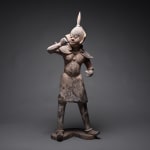Tang Warrior Lokapala, 618 AD to 906 AD
Painted Terracotta
83.8 x 27.9 cm
33 x 11 in
33 x 11 in
PH.0252
Further images
It was during the Tang Dynasty that China’s outstanding technological and aesthetic achievements opened to external influences, resulting in the introduction of numerous new forms of self-expression, coupled with internal...
It was during the Tang Dynasty that China’s outstanding technological and aesthetic achievements opened to external influences, resulting in the introduction of numerous new forms of self-expression, coupled with internal innovation and considerable social freedom. The Tang Dynasty reflected the greatest age for Chinese poetry, painting, and sculpture, although there was a notable decline in Buddhist sculptures following repression of the faith by pro-Taoism administrations later in the regime. During the Tang Dynasty, restrictions were placed on the number of objects that could be included in tombs, an amount determined by an individual’s social rank. In spite of the limitations, a striking variety of tomb furnishings – known as mingqi – have been excavated. Entire retinues of ceramic figures – representing warriors, animals, entertainers, musicians, guardians and every other necessary category of assistant – were buried with the dead in order to provide for the afterlife. Warriors (lokapala) like this one were put in place to defend the dead, while horses/camels were provided for transport, and officials to run his estate in the hereafter.





